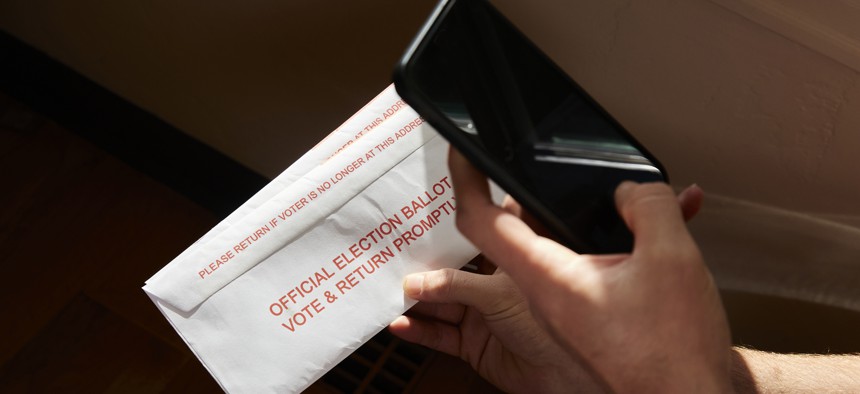Local Election Offices Often Are Missing on Social Media

EyeWolf/Getty Images

Connecting state and local government leaders
COMMENTARY | But election boards that use their social media accounts to share information may improve voter registration and participation, especially among young voters, two professors write.
Local election officials are trying to share voting information with the public on social media but may be missing some key platforms—and the voters who use them.
In early July, for instance, young voters in Boone County, Missouri, complained that they had missed the registration deadline to vote in the county’s Aug. 2 primary election. They claimed no one “spread the word on social media.” The local election office in that county actually has a social media presence on Instagram, Facebook, Twitter and TikTok. But its accounts don’t have many followers and aren’t as active as, say, celebrity or teenage accounts are. As a result, election officials’ messages may never reach their audience.
The Boone County example raises important questions about how prospective voters can get informed about elections, starting with whether or not local election officials are active on social media and whether they use these platforms effectively to “spread the word.”
In our research as scholars of voter participation and electoral processes, we find that when local election officials not only have social media accounts but use them to distribute information about voting, voters of all ages—but particularly young voters—are more likely to register to vote, to cast ballots and to have their ballots counted.
For example, during the 2020 election, Florida voters who lived in counties where the county supervisor of elections shared information about how to register to vote on Facebook, and included a link to Florida’s online voter registration system, were more likely to complete the voter registration process and use online voter registration.
In North Carolina, we found that voters whose county board of elections used Facebook to share clear information about voting by mail were more likely to have their mailed ballots accepted than mail voters whose county boards did not share instructions on social media.
Young People Face Distinct Voting Challenges
Voter participation among young voters, those between the ages of 18 and 24, has increased in recent elections, but still lags behind that of older voters. One reason is that younger voters have not yet established a habit of voting.
Even when they do try to vote, young voters face more barriers to participation than more experienced voters. They are more likely than older people to make errors or omissions on their voter registration applications and therefore not be successfully registered.
When they do successfully complete the registration process, they have more trouble casting a vote that will count, especially when it comes to following all the steps required for voting by mail. When they try to vote in person, evidence from recent elections shows high provisional voting rates in college towns, suggesting college students may also experience trouble in casting a regular ballot owing to confusion about finding their polling place, or because they are not registered to vote because their voter registration application was not successfully processed.
Some of these problems exist because voters, especially young ones, don’t know what they need to do to meet the voter eligibility requirements set by state election laws. Those laws often require registering weeks or months in advance of Election Day, or changing their registration information even if they move within a community.
Social Media: a Tool to ‘Spread the Word’
Social media can be a way to get this important information out to a wider audience, including to the young voters who are more likely to need it.
Younger people use social media more than older voters, with a strong preference for platforms such as YouTube, Instagram and Snapchat.
News outlets and political campaigns use social media heavily. But our analysis finds that the vast majority of local election officials don’t even have social media accounts beyond Facebook. And, when they do, it is likely that they are not effectively reaching their audience.
Gaps in How Election Officials Use Social Media
We have found that during the 2020 U.S. presidential election, 33% of county election offices had Facebook accounts. Facebook is the most commonly used social media platform among Americans of all ages. But two-thirds of county election offices didn’t even have a Facebook account.
Just 9% of county election offices had Twitter accounts, and fewer than 2% had accounts on Instagram or TikTok, which are more popular with young voters than Twitter or Faceboook.
Using Social Media for Voter Education
Local election officials are charged with sharing information about the voting process—including the mechanics of registering and voting, as well as official lists of candidates and ballot questions.
Their default method of making this information available is often to share it on their own government websites. But young voters’ regular use of social media presents an opportunity for officials to be more active and engaged on those sites.
While many election officials around the country face budget and staffing pressures, as well as threats to their safety, our research confirms that when officials do get involved on social media, young voters benefit – as does democracy itself.
![]()
his article is republished from The Conversation under a Creative Commons license. Read the original article.
Thessalia Merivaki is assistant professor of American politics at Mississippi State University. Mara Suttmann-Lea is assistant professor of government at Connecticut College.

NEXT STORY: States Seek to Clarify If Forgiven Student Loans Will be Taxed




